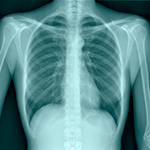
Once someone has had cancer, they have one fear: that it may come back. That fear is heightened for people with deadly tumors, such as lung cancer, the leading cause of cancer deaths in every ethnic group. These patients follow up with regular CT scans to look for tumors, but a new test under study would need just the person's breath.
The breath test looks for volatile organic compounds or VOCs, of which there are thousands in the exhaled breath. Scientists have discovered that the type of VOCs in the breath of lung cancer patients are a subset of chemicals called carbonyls.
All a patient would have to do is blow about one liter of air into a special balloon that's attached to a pump. The pump moves the air over a microchip that traps the VOCs from the breath. A machine called a mass spectrometer reads the chip, identifying and quantifying the compounds.
In the current study, the breath of 31 lung cancer patients were compared with healthy people before and after their tumors had been surgically removed. Indeed, post-surgery, the cancer patients had lower levels of four VOCs associated with lung cancer in their breath. And three out of the four VOCs were at levels comparable to healthy people, so for now the new test does seem accurate.
The study was pretty small, so one involving many more patients' breaths will have to be analyzed to confirm its effectiveness in diagnosing the recurrence of lung cancer. If successful, the test would be superior to the low-dose helical CT scan now being used which has a high false positive rate. You can imagine the emotional and financial strain of a false positive result.
So, at just 20 bucks, and a few hours, the breath test would be a healthier, easier, and possibly more accurate option.
More Information
Lung cancer breath 'signature' presents promise for earlier diagnosis
Being able to identify lung cancer "signature" through a simple breath test has emerged as one of the most promising ways to diagnose the disease. Now the test is being used to monitor for disease recurrence.
Normalization of Exhaled Carbonyl Compounds After Lung Cancer Resection
Presented at the Fifty-second Annual Meeting of The Society of Thoracic Surgeons, Phoenix, AZ, Jan 23'27, 2016.
SEER Stat Fact Sheets: Lung and Bronchus Cancer
From the National Cancer Institute of the National Institutes of Health